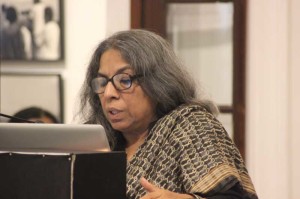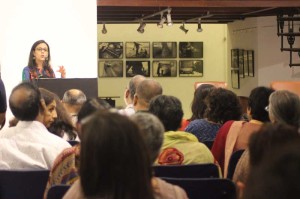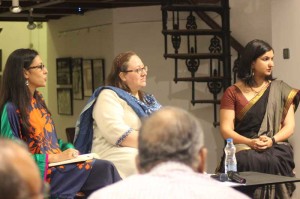On the third day of the conference, the clouds broke down on Kolkata. Roads were flooded, and as I waded through Ho Chi Minh Sarani with Aditi Banerjee at my side, we feared that waterlogged neighbourhoods would deter the participants. No such thing occurred however, and very soon towels and irons were brought out to help dry the enthusiastic participants who were trooping in. We allowed some time for everyone to arrive before beginning the day. Professor Choudhury used the time we were waiting to share stories that he had come across during his research about the partition of Bengal about unlikely heroes.
When Urvashi Butalia took the podium to deliver her keynote address at 11.00 a.m., the first thing she did was congratulate the participants for turning up despite the weather conditions. She then went on to talk about the importance oral history and the step treatment it has received so far from historians.. Opening up your mind to new research is not a threat to old research–-it is simply building on it, she said. In many ways it helps incorporate incidents that history forgets to record –- such as memories from the survivors of a school shootout in Lahore, who opened up during the Lahore Literature Festival. If there is a right moment to deal with divided histories, it is now –- there is a very small window of time for this research. She shared how the partition had affected her own life –- her mother’s brother had stayed back along with her grandmother and converted to Islam. When she went back to Lahore to reunite her family, her eyes opened to the blood ties that exist across the border making the divided history of the partition a history tied in blood, a linked history.
What effect did the partition have on older people? Those whose families are ripped apart, those who lose their children forever? What happens to the stories of women who were abducted and raped? Their families look away from the trauma, simply saying that they were taken away. In some cases the families traded their women for safety. Even if these women, abducted or traded, fought their way home, they were banished as impure. She spoke about one such experience while collecting the stories – an entire district told her about two girls who had been abducted from a family, everyone, but the brothers who never mentioned the existence of a sister. When Ms Butalia started looking for these survivors, she could find them only in books, no one came forward in real life. What about the Hindu and Muslim children who were abducted during the partition by believers of the other religion? They believed that the Hindu child would bring intelligence into their family line while the Muslim child was thought to be the harbinger of beauty. People have a habit of othering violence, circumventing the domestic violence which was rampant in this period – women and children were killed to preserve their ‘purity’, stories which are brushed under the carpet. Here arises the ethical question for the researcher- who does the researcher hold allegiance to?
She picked up the interesting story of Maya Rani from Gurdaspur, Deenanagar. A dalit, Rani escaped the violence courtesy her caste. The dalits were, at that point in time, politically located at a point where everyone located them. But that was not all – when people ran away from their homes, she, along with friends, looted the vacated homes and then lived the rest of her life on the spoils. There was also the story of the hijras who too had to choose their sides and the inspiring story of a couple who chose different sides but, along with their friends, disregard the boundaries to celebrate togetherness once every year.
She ended with the story of Damayanti, a rehabilitator who worked with women to promote employability. She came up against a law that required the women to be under 28 to apply for work. They had to provide proof of age in the form of affidavits. Very few of the women she worked with were below that age and she wanted all of them to get jobs that they desperately needed. She initially tried to make the government officer sign the affidavits without seeing the women. When he refused, she reluctantly brought them into the room and proceeded to account for their wrinkles and missing teeth, saying that they suffered from malnutrition. It took her over an hour, but the officer finally did sign the affidavits that stated the women were within the age of employment.
When Professor Choudhury asked her about rape as a tool used by the military to mark their strength, Ms Butalia said that the women would feel more betrayed if their own families gave them up in exchange for safety. If they reached back to their families, they were turned away more by the Hindus who thought that having sex with someone outside of your religion polluted you than the Muslims who do not believe the same. When asked if she had pursued the story of the two sisters who the brothers failed to mention, she said that she felt it ethically wrong to do so as it builds hostility in a relationship that is built on trust. Her decision to not pursue the subject was much more dependent on the silence enforced on it by the women. Ethically, a researcher is responsible to respect that.
Oral histories may never, as claimed by its critics, get to the truth of things. It does, however, collect strands of the truth and provide a platform for the voices of ordinary people.
The Partition(s) Within and Without
Following the Keynote, Swaleha Alam Shazada took the podium to share with us the work that is being done by the Citizen’s Archive of Pakistan. Joining her on stage were Aditi Banerjee and Tina Servaia. Along with collecting oral histories, CAP has started Exchange for Change, an initiative which aims at improving relationships between students from India and Pakistan. Through sustained interaction CAP believes that students from both sides of the border will be able to understand their respective cultures and ways of life much better, helping to eliminate cultural misconceptions among the young generation. She screened an A/V presentation of CAP’s work within the Exchange for Change initiative which began with 170 students and has now reached 8000. Students interact through postcards, letters, collages, photographs and oral interviews with the generation who saw the partition. Finally the year long project ends with students visiting each other across the border.
Swaleha then spoke about the oral history archive that CAP is engaged in building. Not having any one who could train them–- they trained themselves, to become archivists. Collecting the stories was found to be much easier than disseminating them. They initially wanted to build an oral history museum, exploring the story behind the pictures they collected while collecting stories. They listened to the stories, looked at the memorabilia and built interactive lesson plans which they then took to schools in the country. Not attempting to change the present curriculum, they developed an alternative discourse for the teachers to use. When the schools did not have a/v facilities, they developed resources from the material available in the schools. She played recordings they use to assist in the current curriculum among which were the story of a woman whose family migrated to Pakistan who joined the Women’s Guard and that of a woman who recounted the state of mourning in Pakistan at the demise of Muhammad Ali Jinnah. Interestingly, the man whose demise incited such feeling in his country, has been accorded only two paragraphs in the social studies textbook of the Sindh board which have no mention of war crimes and talk about the fall of east Pakistan. The CAP curriculum seeks to add to where the official curriculum economises with their lesson plan on riots and migration. The plan first incorporates texts to make the students aware of riots and then provides them with oral narratives of people who have been part of riots. Then the students are made to connect these events of history with events of the represent
Oral histories, she said, let gaps be filled.
Aditi Banerjee then took the time to share with us projects that her students have developed concerning personal and collective memory with respect to the Partition and the 1984 riots in Punjab. The presentations developed by the students were to seek empathy, not information.
Involving artists and students who have not been directly affected by the trauma of the partition, the project allowed for optimal ambiguity in the enquiry made through an artistic process, negotiating the private, personal and political in memory. The first project she shared was Memory Lab which was conducted in 2013 over 5 weeks with 8 students. The students experimented with key ideas such as representation, poetics and politics. The Elephant in the Room, a project conducted in 2014 over 5 weeks with 8 students centred on the silences around the partition, exploring whether the event was one located in the past or still happens every day, today. They travelled to Preetnagar where the students were to conduct research for their projects.
To Need a Flag was part of one the projects. It went –
We hung the partition
On a wall with flowers
We hung the partition
In the mind, imageless
Another poem enquired the responsibility of sharing the past –
I heard a story. Should I tell you?
Or should it be left behind where it came from?
I’m confused.
While one girl discovered that one of her beloved family members was a perpetrator of violence during partition, another looked at duality of horror and beauty while another walled himself up over a period of days to understand what it is like to wall oneself away from the other. Ms Banerjee also screened parts of a short film, Lakeer, a product of this project, it dealt with the metaphors of brutality.
At the start of the following discussion, Ms Servaia observed how these two women, dealt with the same subject in completely different ways –- Ms Shahzada in her work with CAP bringing in objectivity to the events of the past while Ms Banerjee’s projects helped to internalise the past. She then proceeded to ask Ms Shahzada how CAP ensured the reliability of the oral history narratives collected. Ms Shahzada shared that the techniques of collection had changed over the years and there was now an established code followed by all the archivers. Since people associate emotions with their memories it is important for the researcher to know the context and build an apt questionnaire does not involve emotions which in turn bring in hearsay. When asked what happens when the interviewee’s memory is altered. Ms Shahzada emphasised the need to not object to the interviewee’s version. The idea of CAP is to upturn the arguments of the existing curriculum, to inculcate tolerance, lead the children to question, and do all of this under the radar, explained Ms Shahzada when asked if their supplementary texts were meant to mitigate official versions.
Professor Jha said that historians should not be suspect of oral history since that’s where it all began. It is important for the teacher to know what they want their students to learn –is it just a knowledge of facts they want to encourage or do they want the students to understand historical enquiry? How can we look at the partition as a transdisciplinary notion? The displaced people of Narmada are as much a part of the partition as any other family affected. People, said Dr Christophe, remember in two ways – the experience itself and how they go on to live with the experience. Oral history narratives are pursuing the stories of the of the stories of the perpetuators? Ms Shahzada shared that when CAP had created a digital database through their initiative Am I Next? where people could phone in and record stories of violence, they not only received coverings of the witnesses of violence but also confessions of perpetuators. Ms Vivekanand said that this was probably because stories help close the loop, whether it is a personal story or a fictionalised account of the incident – it feels better to share.
Even as war crimes do not find mention in Pakistani textbooks, they are paramount to the Bangladeshi ones, said Ms Ghosh, creating a feeling of victimhood. The crimes have to be reported in their historical context, which is missing the texts. When she asked Ms Shahzada why she would want the textbooks to incorporate more about Muhammad Ali Jinnah at the cost of other material, she was told that it was because Ms Shahzada did not want her Quaid-i-Azam to be reduced to a national holiday.
Gulan Kripalani then asked if recordings of the perpetuator, done in secret, could be incorporated in oral history. It would certainly be unethical said Ms Shahzada – the standard norm is to sign a release form. Dr Christophe agreed to that but wondered what the experience of a perpetuator would be if they agreed to be recorded. Professor Sethi shared how a colleague of his had asked him to take an interview because he wanted to confess in 2002 to a murder that he had committed in1947. He opined that perhaps sharing it is cathartic for the perpetuator.
Ms Butalia then went on to share her experience of talking with men who had killed their families to save them from dishonour. She initially did not want to speak to them, but then she spoke to a man who was responsible for killing around 18 members of his family who he considered martyrs. She ended up liking him. Concerning the secret recordings of people like Babu Bajrangi, she would have no compunctions in sharing them with the public. This resort to subterfuge would only be justified because people like him would not otherwise confess to their crimes.
At the end of the discussion the audience was left with a question – in the histories of trauma, whose story should gain more importance? That of the victim in an attempt to understand the horror they had to endure? Or that of the perpetuator in an attempt to understand their motive for inflicting violence on others in order to avoid it in the future?
Workshops
The afternoon saw the participants divide into small groups and occupy different spaces throughout the Harrington Art Centre, enthusiastically involved in the different workshops that were going on.
Ending Remarks
As the conference came to a close, when Megha Meena Malhotra took the podium to thank everyone who had been a part of the conference, a resounding audience thanked her and Ms Sengupta instead, for organising such a splendid conference. We have to look at history as a route to peace, as a mode of reassessing our faults and flaws in an effort to build a harmonious world, said Ms Malhotra. She ended the conference by declaring that without historians, time would come to a standstill.
-Anushka Halder



